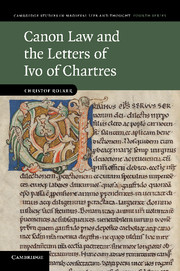Book contents
- Frontmatter
- Contents
- List of abbreviations
- Note on the citation of manuscripts
- 1 IVO OF CHARTRES – ‘LIFE AND LETTERS’?
- 2 CANON LAW BEFORE IVO
- 3 COLLECTIONS KNOWN TO OR COMPILED BY IVO
- 4 THE CANON LAW IN IVO'S CORRESPONDENCE
- 5 HIERARCHIES OF AUTHORITY: IVO's VIEWS ON DIVINE LAW AND THE ECCLESIASTICAL HIERARCHY
- 6 THE LAWS OF MARRIAGE: ‘QUOD ET NATURA DISPOSUIT, ET LEX TAM ECCLESIASTICA QUAM MUNDANA FIRMAVIT’
- 7 IVO'S DECRETUM AND THE PANORMIA: CHARACTER, RECEPTION, AUTHORSHIP
- 8 IVO'S PASTORAL CANON LAW AND HIS PLACE IN LEGAL HISTORY
- Appendix: A concordance table for the quotations in Ivo's letters
- Bibliography
- Index to single letters of Ivo of Chartres
- Manuscript index
- General index
1 - IVO OF CHARTRES – ‘LIFE AND LETTERS’?
Published online by Cambridge University Press: 04 August 2010
- Frontmatter
- Contents
- List of abbreviations
- Note on the citation of manuscripts
- 1 IVO OF CHARTRES – ‘LIFE AND LETTERS’?
- 2 CANON LAW BEFORE IVO
- 3 COLLECTIONS KNOWN TO OR COMPILED BY IVO
- 4 THE CANON LAW IN IVO'S CORRESPONDENCE
- 5 HIERARCHIES OF AUTHORITY: IVO's VIEWS ON DIVINE LAW AND THE ECCLESIASTICAL HIERARCHY
- 6 THE LAWS OF MARRIAGE: ‘QUOD ET NATURA DISPOSUIT, ET LEX TAM ECCLESIASTICA QUAM MUNDANA FIRMAVIT’
- 7 IVO'S DECRETUM AND THE PANORMIA: CHARACTER, RECEPTION, AUTHORSHIP
- 8 IVO'S PASTORAL CANON LAW AND HIS PLACE IN LEGAL HISTORY
- Appendix: A concordance table for the quotations in Ivo's letters
- Bibliography
- Index to single letters of Ivo of Chartres
- Manuscript index
- General index
Summary
‘SCRIPSIT AD DIVERSOS AMICOS UTILES VALDE EPISTOLAS’: A CONTEMPORARY VIEW
Early in the twelfth century, in the abbey of Gembloux, a monk called Sigebert assembled a catalogue of Christian writers from biblical times to his own era. 1 Such lists of ecclesiastical authors had been drawn up since patristic times; the most illustrious example was the one compiled by St Jerome in 393, in which he famously included an article on his own works as the last entry. In the early Middle Ages, Jerome's catalogue and similar literary histories were copied frequently, yet for centuries, medieval authors had refrained from adding more recent authors to these lists. Indeed, Sigebert of Gembloux (d. 1112) was the first literary historian to include a small share of living authors. Yet even Sigebert, who boldly followed the model of St Jerome in devoting the last entry to himself, listed only very few living authors. This lends special weight to his entry on the bishop–scholar Ivo of Chartres (d. 1115):
Ivo, bishop of Chartres, wrote to Hugh, archbishop of Lyon and apostolic legate, a letter not of great length but abundant with canonical and catholic proof texts, on the discord of regnum and sacerdotium and unwonted decrees of the Roman church. He also wrote very useful letters to different friends, and further compiled a great volume of canons.
Ivo was bishop of Chartres from 1090, and had soon become widely known well beyond his diocese, especially after his public conflicts with Archbishop Richer of Sens, with King Philip I and with the papal legate Archbishop Hugh of Lyon.
- Type
- Chapter
- Information
- Canon Law and the Letters of Ivo of Chartres , pp. 1 - 49Publisher: Cambridge University PressPrint publication year: 2010

